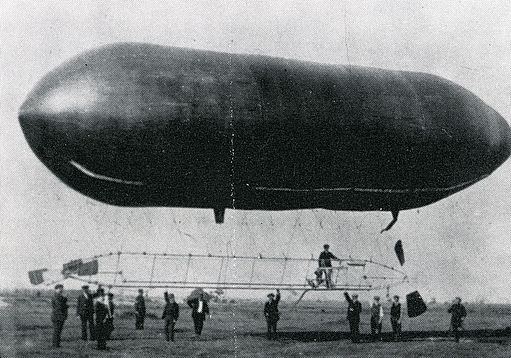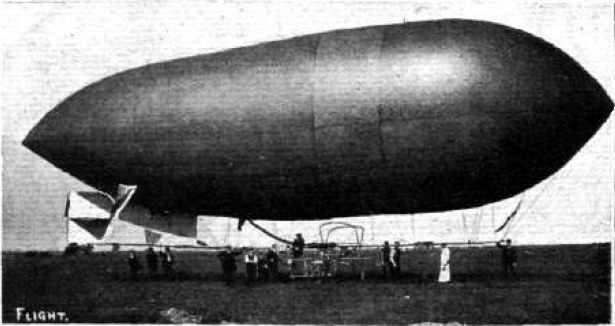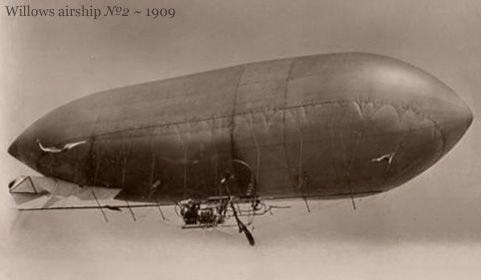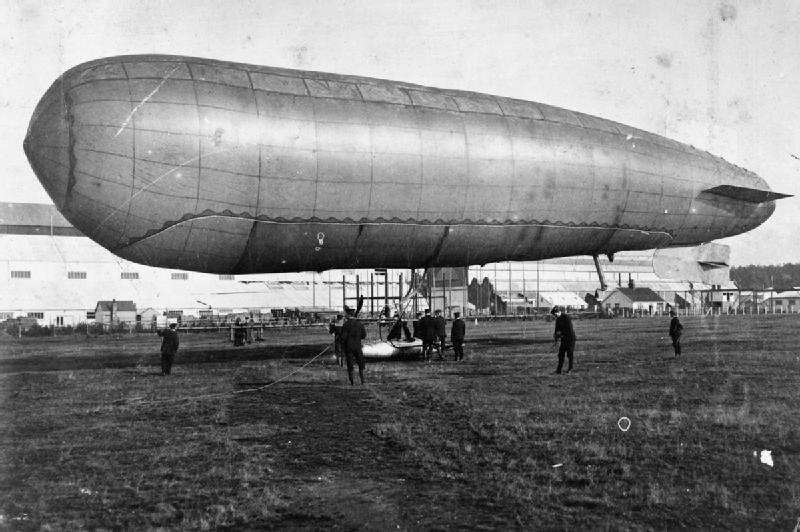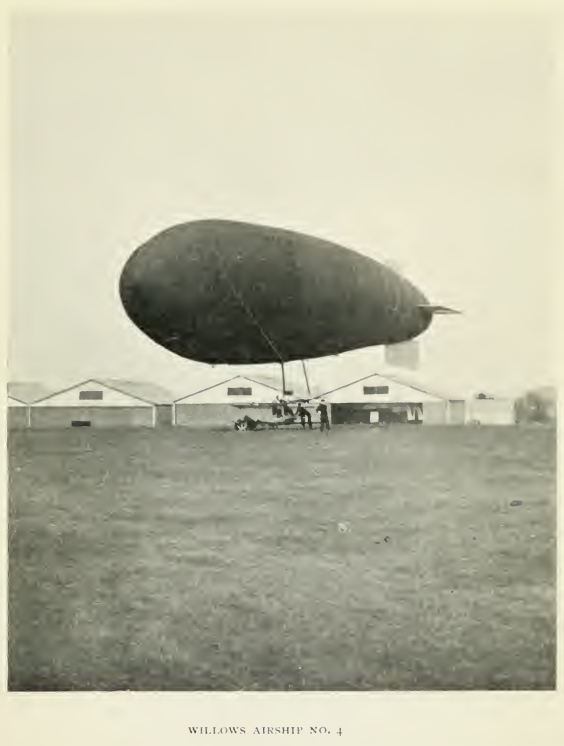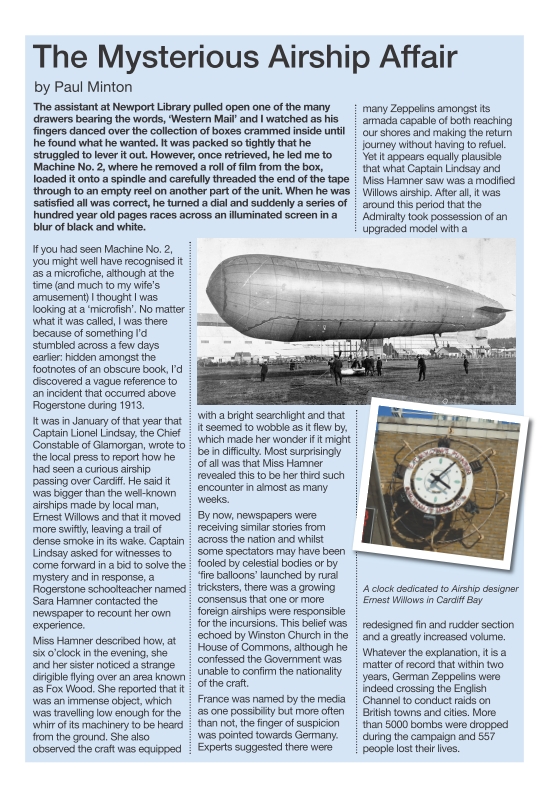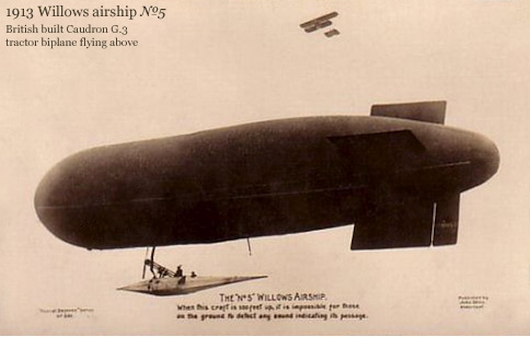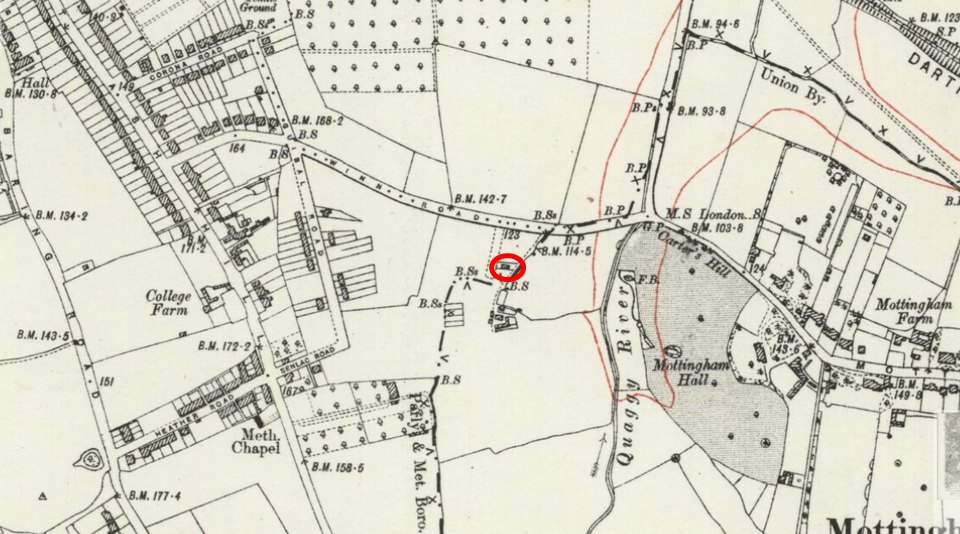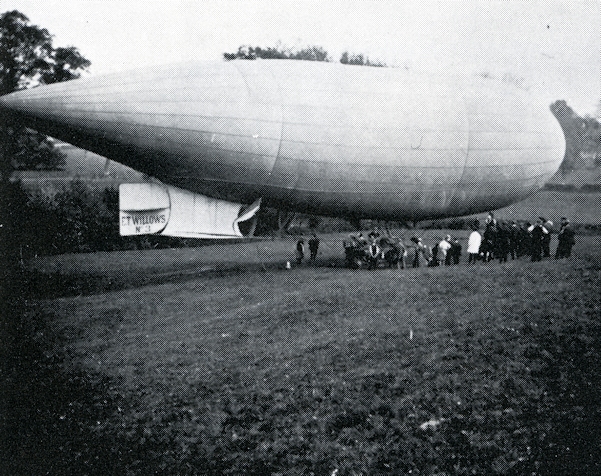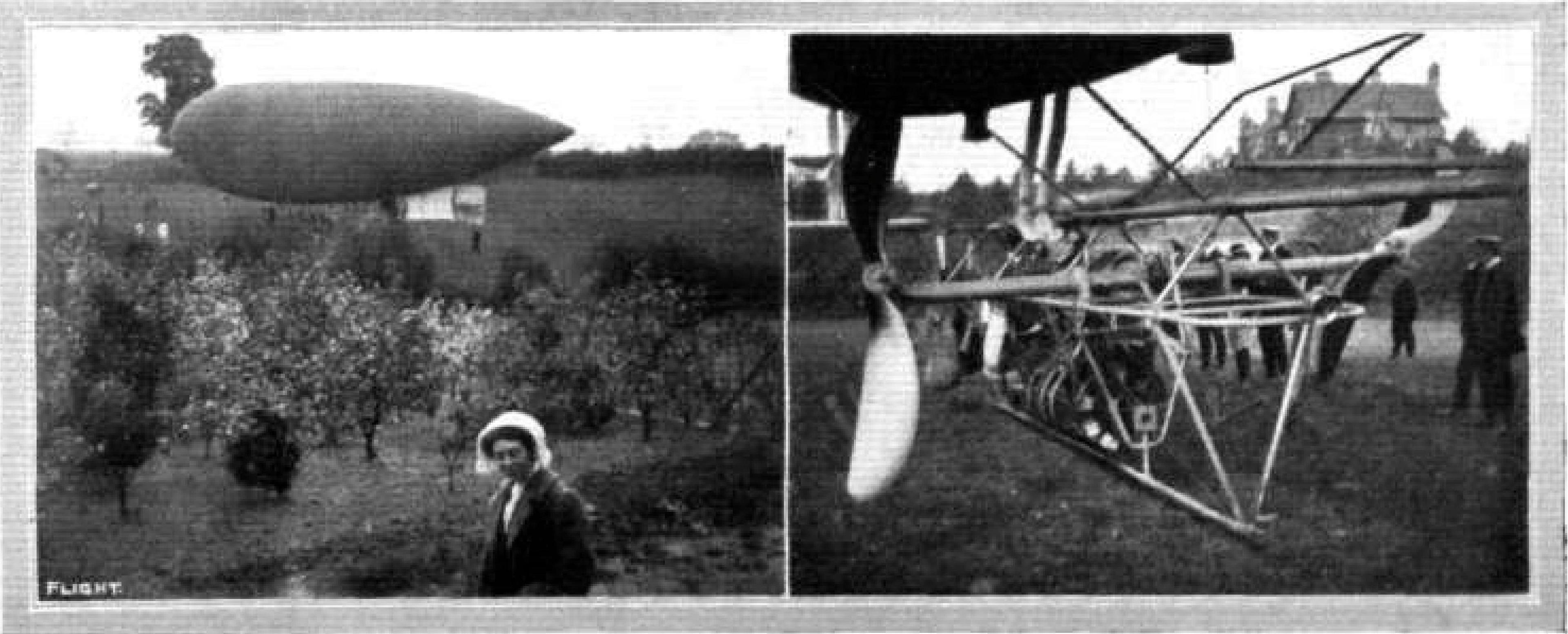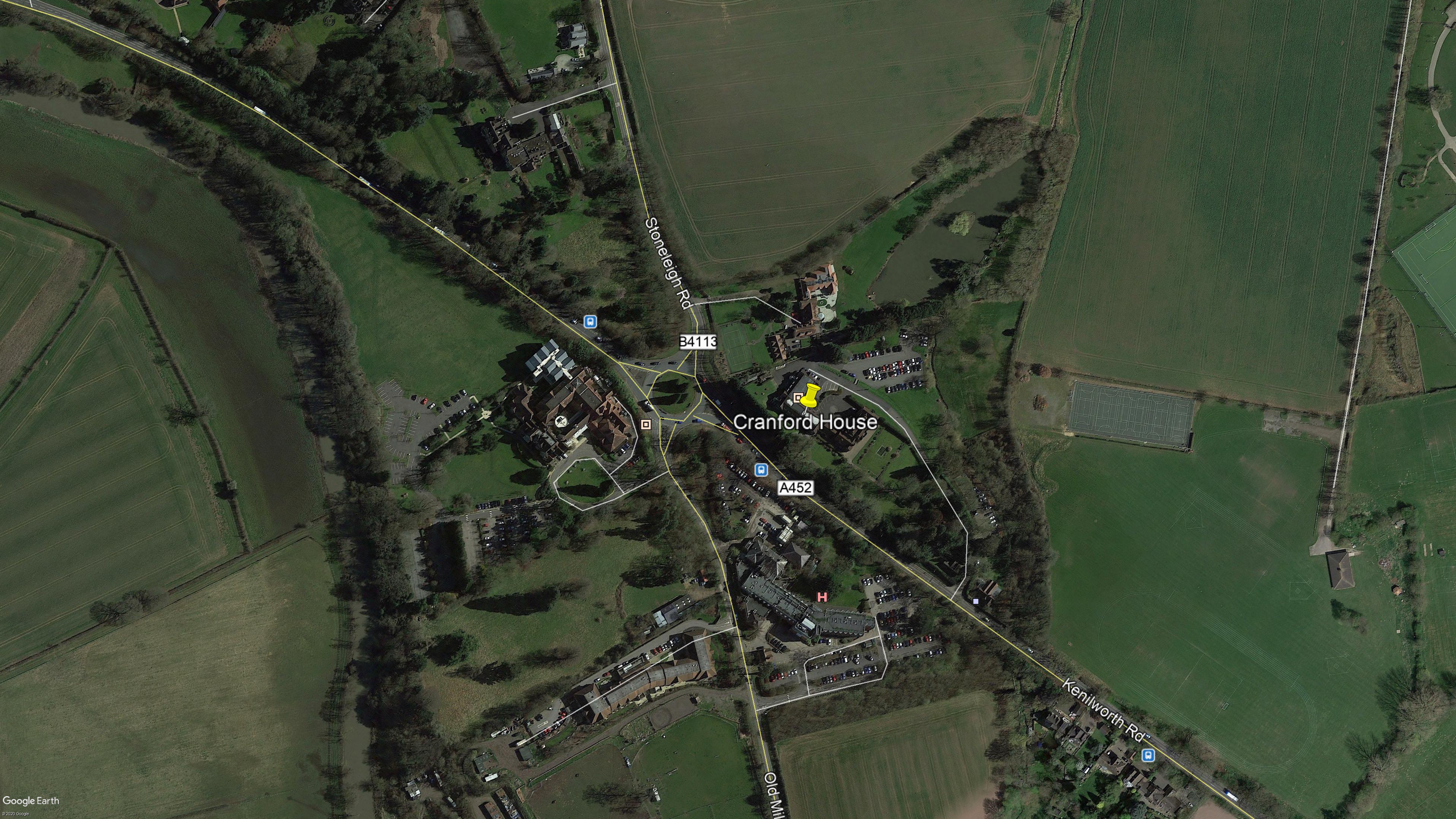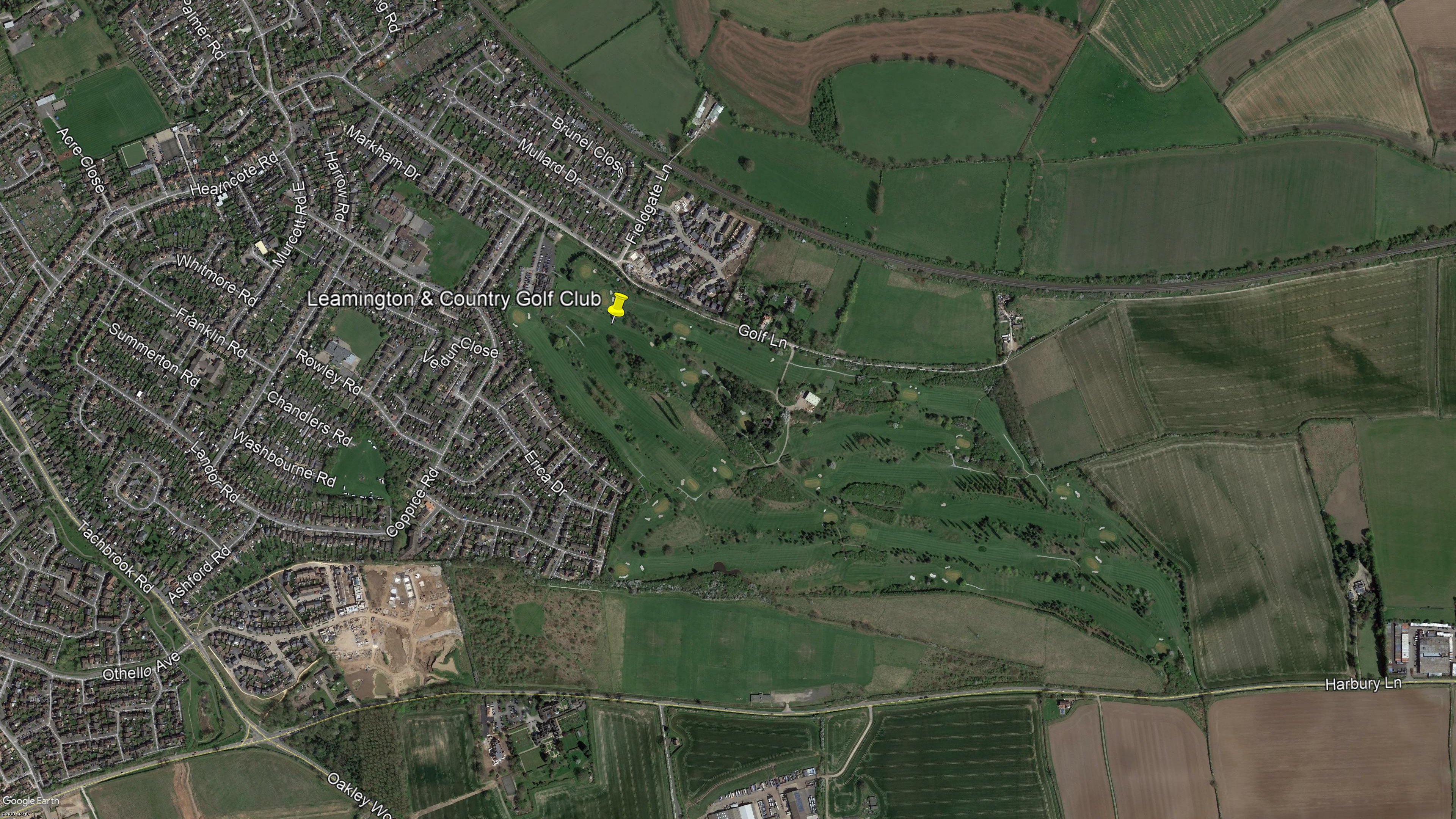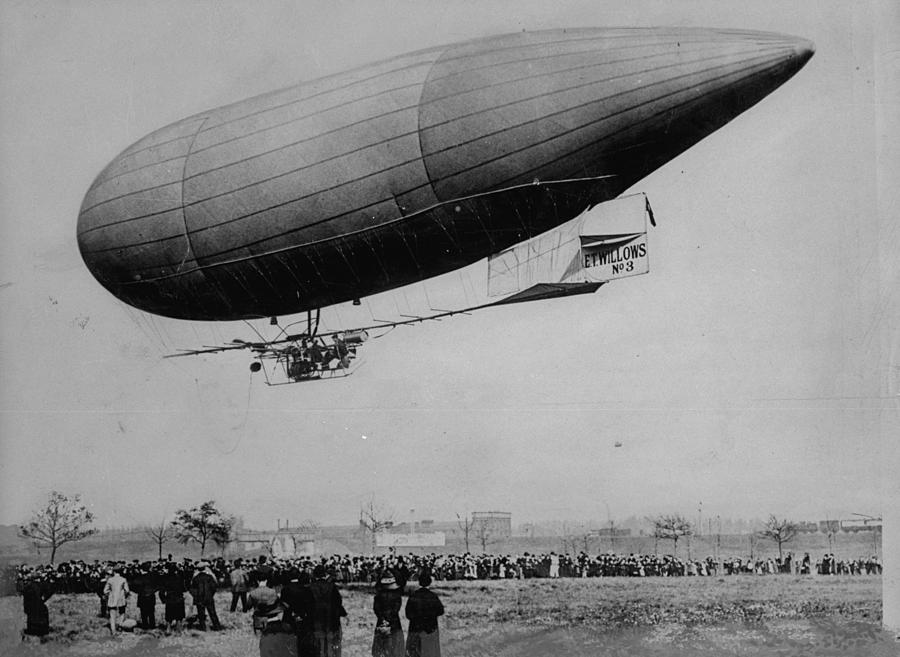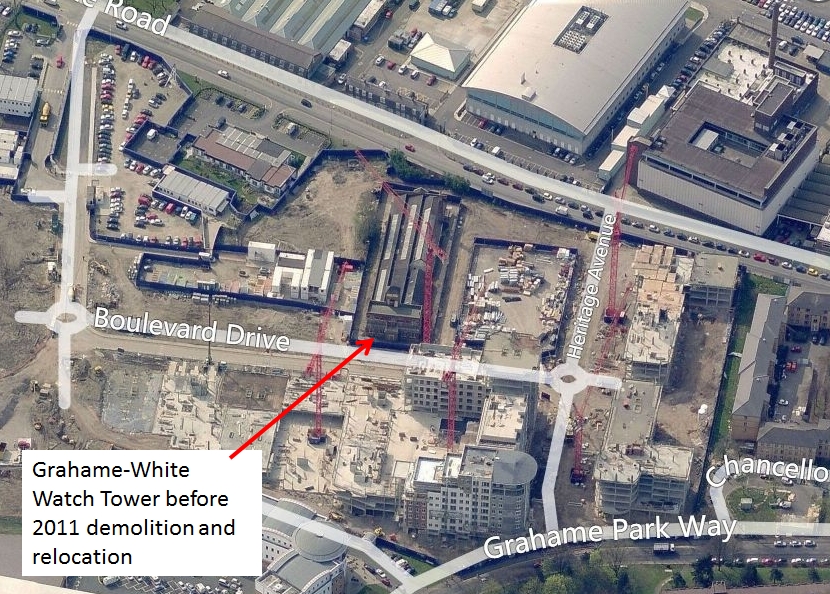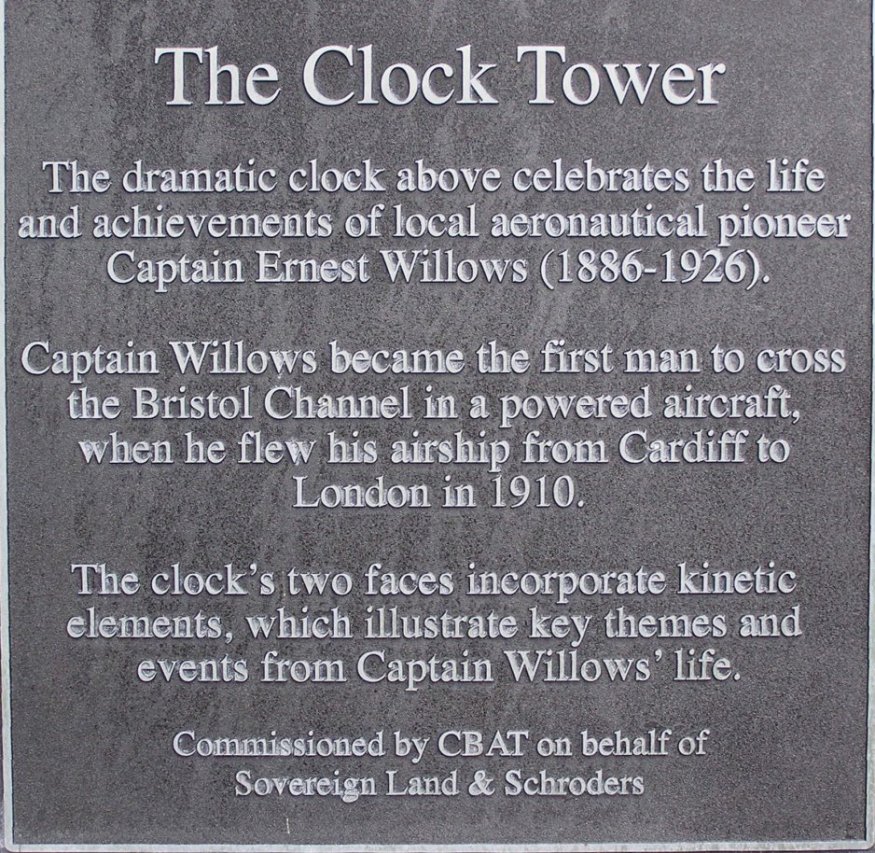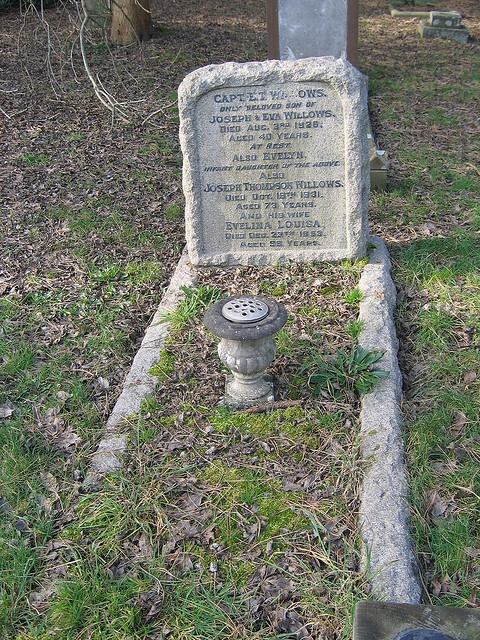Ernest Thompson Willows was born in Cardiff, United Kingdom, on July 11, 1886, son of Joseph Thompson Willows, a local dentist. Ernest was on-track to follow in his father's footsteps into dentistry when, sometime after 1903 he became smitten with airships, probably upon reading newspaper accounts of the efforts of Alberto Santos-Dumont and of Captain William Beedle who was experimenting with airships in London at the time. (Willows admitted in 1911 that he had, indeed, been inspired by the exploits of Santos-Dumont!) Willows built his first airship at age 19, with his own design loosely based on Beedle's work. This first airship was the "Willows No. 1" and he ascended on the first flight on Aug 5th, 1905, a flight which lasted more than an hour and is said to have been the first controlled flight in an airship in Britain! Between 1906 and 1908 Willows teamed with Beedle to make airship gondolas for the British Army when Beedle came to Cardiff. After that, Willows set out to design and build his No. 2 using his growing skills.
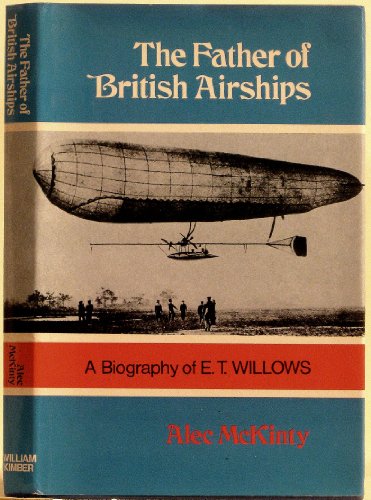 Over the course of the next 21 years, Ernest Willows builds 4 more airships and gains much fame, but little fortune. Nevertheless, he is considered in aviation circles as the "Father of British Airships". Today, despite earning "Airship Pilot Certificate No. 4" from the Royal Aero Club of England, (the 1st certificate to a civilian), he is little known and there exists no stone monument to his accomplishments. There is a wonderful book about him, seen at right, "The Father of British Airships", by Alec McKinty, 1972. His home town of Cardiff, long changed since the days of airships, has a pub named after him, and a tower clock honoring him.
Over the course of the next 21 years, Ernest Willows builds 4 more airships and gains much fame, but little fortune. Nevertheless, he is considered in aviation circles as the "Father of British Airships". Today, despite earning "Airship Pilot Certificate No. 4" from the Royal Aero Club of England, (the 1st certificate to a civilian), he is little known and there exists no stone monument to his accomplishments. There is a wonderful book about him, seen at right, "The Father of British Airships", by Alec McKinty, 1972. His home town of Cardiff, long changed since the days of airships, has a pub named after him, and a tower clock honoring him.
This page is about the Willows airships and recovering some interesting sites where Ernest Willows' airships were seen, but I will make note here of the sad end to Ernest Willows life. Some say Ernest Willows failed as a business man. But nothing could be further from the truth. As a very young man, he created his own Airship company, "Willows Aircraft Company Ltd", his factory in Cardiff, and during World War I he employed around 150 people making kite and barrage balloons for the British war effort. One of his airships, his No. 4, was purchased by the British Admiralty. Unfortunately, he failed to receive the recognition he deserved and after the war, was reduced to flying passenger-carrying balloons at fairs and events, nearly broke from his exploits in airship production. He died at age 40 when, on Aug 23, 1926 at Hoo Park in Bedford, the envelope of his passenger balloon ripped from its netting and he and his passengers fell to their deaths.
Jump to specific Willows Airship: No. 1 * No. 2 * No. 3 * No. 4 * No. 5
Jump to specific Site of Interest: Cardiff * East Moors * Lee * Leamington Spa Warwickshire * Wormwood Scrubs * Hendon Aerodrome * Willows Clock Tower * Willows Grave *
Identifying Willows Airships
During the course of this investigation I found many exciting locations, detailed below, but first, I think it is appropriate to describe how the 5 Willows airships can be distinguished from each other. Like so many of the early airships, they are often confused with other airships and with each other in period photographs.
Willows No. 1
Built in 1905, Willows' first airship at age 19, offered some very unique features amongst airships of the day. Most notable is that it flew and was navigable! In addition to a 10 foot diameter, pusher propeller, the engine drove a pair of propellers in the front. These tractor propellers could be swiveled to direct their thrust and thus the ship could turn, ascend or descend without the use of rudders or elevators. The gas envelope of the No. 1 was 72 feet long, 18 feet in diameter, made of varnished silk (common among the early, small airships of the era), carrying a 30 foot long, triangular, steel-tube frame gondola.
The "Willows No. 1"
Photo credit: Public domain
The photo above is one of only two photos of the Willows No. 1 I've seen, so here is a drawing of it from "D'orcy's Airship Manual", 1917, to illustrate its simplicity and design:
Photo credit: D'Orcys Airship Manual, 1917, Public domain
Unlike the Knabenshue No. 1, flown the same year, the Ernest Willows did not have to scramble precariously forward and aft on the framework gondola to ascend and descend. The Willows No. 1 had a pair of articulating propellers at the bow, driven by the same engine driving the pusher propeller, which Willows could direct to provide thrust at the bow end to turn, climb and descend. Willows could control the airship while remaining near the engine controlling the forward propellers with levers. An article in the Dec 3, 1910 Scientific American Supplement says Willows made 6 flights in the No. 1, and then embarked on the design and construction of the No. 2.
Here is the only other photo of the No. 1 I found. It is from the 1976 edition of "Jane's Pocketbook of Airships":
Photo credit: Jane's "Pocketbook of Airships", 1976, pg 90.
Note that though the first photo above shows two people on the No. 1 frame, the first photo is of the "original" No. 1, and to prevent the center of the inflated gas envelope from sagging in the middle (as can be seen in the photo), very soon Willows extended the gondola framework to 45 feet. Examine the 1st and 3rd photos and you can see this change. The modified No. 1 is sometimes called the "No. 1a". The No. 1 (and 1a) was designed to fly "heavy", meaning even with the lifting hydrogen the entire vehicle remained about 40 pounds heavy and would stay on the ground. The airship would be lifted by a ground crew, and thrust would propel the craft into the sky while the forward propellers, tilted up would lift the stern and the ship could ascend under power.
Specifications:
- Length: 72 ft (21.9 m)
- Max Diameter: 18 ft (5.5m)
- Envelope ratio (L/D): 4.0
- Operating dates: Aug 1905 to ~end of 1905
- Visual: Open frame, 33 foot steel-tube gondola, pusher prop, dual, articulating propellers at forward end. No horizontal or vertical fins on envelope or gondola. No rudder.
Willows No. 2
Willows flew the No. 1 only six times according to the available record. There may be numerous reasons for this, but quite possibly he was either dissatisfied with the performance of the No. 1 or he already had bigger and better ideas. Whatever the reason, he debuted the Willows No. 2 in November, 1909. The No. 2 was larger than the No.1 and displayed many innovative changes.
The "Willows No. 2"
Photo credit: "Flight" magazine, July 2, 1910, pg 509, Public domain.
Photo credit: Extracted from Rosebud's Early Aviation Archive, http://www.earlyaeroplanes.com/archive/airships01/1909.Willows.No.2.jpg, Public domain
Visible innovations include a single tube keel, 58 feet in length, made rigid with cross-bracing and wire; a larger tubular open frame single-seat gondola slung centrally on the keel; twin, tilting propellers now located on the gondola near the engine; no pusher prop, and a new vertical fin and cruciform rudder. Steering the No. 2 was by the new rudder, while ascent and decent were affected by the tilting twin propellers.
Specifications:
Initial design:
- Length: 86 ft (26.2 m)
- Max Diameter: 24 ft (7.3 m)
- Envelope ratio (L/D): 3.58
- Operating dates: Oct 1909 to ~Aug 1910
- Visual: Vertical fin and rudder, keel, larger centralized open-frame, single-seat gondola. From November 1909 to February 1910 twin propellers, formed by steel tubes with aluminum blades only covering the outer third of the propeller diameter. From (approx) March 1910 and later, solid "Handley Page" built propellers.
Rebuilt as No. 3, "City of Cardiff:
- Length: 105 ft (32 m)
- Max Diameter: 25 ft (7.6 m)
- Envelope ratio (L/D): 4
- Operating dates: Nov 1910 to ~Oct 1911
- Visual: Single-tube boom keel, rudder and vertical fin; fixed, kite-shaped horizontal stabilizer; larger centralized open-frame, two-seat gondola. Twin, Handley Page propellers.
Willows No. 3
The Willows No. 2 was short lived. Though Ernest demonstrated the No. 2 publicly, and several photos of it exist, by the end of October 1910, he had removed the No. 2 from service and rebuilt it. Turns out Willows was seeking something he could do to "put his name on the map", and he decided a Channel crossing non-stop to Paris would do it. That would be a note-worthy achievement, as yet never-before-done. But to cross the Channel he'd need a larger airship. The "new" incarnation of the No 2, became the No. 3 and then soon after that was renamed "City of Cardiff". The City of Cardiff was used to cross the English Channel on November 4, 1910, Ernest Willows becoming the first Brit to cross the Channel by airship.
The "Willows No. 3"
Photo credit: 1911 post card, Public domain.
Here is an earlier view. (Note the "kite" shaped horizontal stabilizer is missing a panel seen in the later photo, above):
Photo credit: Extracted from a 1910 era postcard, Rosebud's Early Aviation Archive, http://www.earlyaeroplanes.com/, Public domain, corrected for distortion.
The No. 3, City of Cardiff, is difficult to distinguish from the No. 2, but the most obvious discriminator are the visible differences in the longer-looking tail of the envelope (because the No. 3 envelope was a larger design than the No. 2 envelope), and the addition of a horizontal stabilizer to the keel, and in clear photos, the words "E.T. Willows No. 3" printed on the side of the rudder. The keel boom of the No. 3 is also 10-14 ft longer than the No. 2's keel, but this is terribly hard to discern in photos.
Specifications:
Initial specs as "City of Cardiff", October 1910:
- Length: 105 ft (32 m)
- Max Diameter: 25 ft (7.6 m)
- Envelope ratio (L/D): 4
- Operating dates: Nov 1910 to ~Oct 1911
- Visual: Single-tube boom keel, rudder and vertical fin; fixed, kite-shaped horizontal stabilizer; larger centralized open-frame, two-seat gondola. Twin, Handley Page propellers.
Possible modification of the "City of Cardiff" still larger, after March 1911 to sometime in 1912:
- Length: 120 ft (36.6 m)
- Max Diameter: 40 ft (12.2 m)
- Envelope ratio (L/D): 3
- Operating dates: Unknown
- Visual: Unknown. No photo of this modification has been identified.
Note on these dimensions for the No. 2 and No. 3: The available publications provide specs for the No. 2 and No. 3 that are all over the place. The length and diameter of the No. 2 & No. 3 is reported as (No. 2): 80 ft x 22 ft, 83 ft x 22 ft, 86 ft x 22 ft, 82 ft x 22 ft, 82 ft x 20 ft; (No. 3): 110 ft x 26 ft, 120 ft x 40 ft. This posed a dilemma on just what measures to post in this article, so I solved the problem by identifying something in the frame gondola the dimensions of which I was satisfied I could estimate, and making repeated measures from the available photos and taking the average measurements. This method, I suspect, produces a length slightly shortened from the design length due to a "drawing-in" of the envelope fore and aft as it is inflated, while the diameter is somewhat constrained by the permitted diameter of the circumferential ropes or cables around the envelope. I estimated that the maximum cross-section diameter became somewhat oblate or oval when inflated, with the vertical diameter about 1.12 times longer than the horizontal diameter so I compensated for this in my measurements.
Photo confusion:
There is also an anomaly in some photos of the No. 3, "City of Cardiff" because there exists photos, published widely, which do not match the proportions of any known configuration of the No. 3! It's envelope length to diameter ratio in these photos is found to be 4.5, not found in any known modification of the No. 3. It is not at all clear why this photo, published in 1910, was "stretched", but a "working theory" is that the photo was stretched to fit on a post card at the time. Here is what I mean:
Photo credit: 1910 post card, Jean-Pierre Lauwers collection,Public domain.
This post card demonstrates a No.3, seen nearly side-on, which is quite long compared to its diameter but there is no configuration of the Willows No.3 which had an envelope length to diameter ratio of 4.5 such as this. So here is the same image, from a Nov 1910 "Flight" magazine, which serves to provide a solid date so we know the envelope was 86 feet long at that time. The corrected image is compared to the published image:
Photo credit: "Flight" magazine, Nov 12, 1910, pg 935, Public domain.
Just how, in 1910-1911, the photo ended up "stretched" I am at a loss to explain.
And as a final note on the No. 3, I found no photos showing its configuration with a 120 ft x 40 ft envelope reported in several articles as the "eventual" or "ultimate" size of the airship. The distinctive length to diameter ratio of 3.0 for these dimensions would be clearly visible.
Willows No. 4
The No. 4 has an interesting though sketchy history. Willows built the No. 4 at his new shop in Birmingham and in early 1912, sold it to the British Admiralty despite a military inspector's report that the airship had value only for training and no other practical value to the army or the navy! Nevertheless, the WIllows No. 4 was commissioned "His Majesty's Naval Airship No. 2" in September 1912.
The "Willows No. 4 (Note it is misidentified as 'The Baby')"
Photo credit: Rosebud's Early Aviation Archive, http://www.earlyaeroplanes.com/archive/airships01/1912.Willows.4.Naval.Airship.2.jpg
This photo shows the Willows No. 4 (HMNA No 2.) in its initial configuration with a triangular vertical stabilizer on the stern of the keel, and a dark-colored rudder of the typical Willows design. Publications of the day often misidentified the Willows No. 4 as the 'Baby'. We know it is misidentified because also seen in the photo is the Beta, which was modified in 1910 and had used and enlarged the envelope from the "Baby"! So when this photo was made the "Baby" no longer existed!
For reasons unknown, the Admiralty felt the HMNA No.2 was inadequate and needed modifications. The fin and rudder on the keel were removed and fitted to the stern of the envelope, then envelope was enlarged to 62% more volume some time in 1913. The HMNA No. 2 was then only used sporadically in training till Jun 1914. Some time after June, the Willows two-seater gondola was replaced with a three-seat gondola.
Still for reasons unknown, the vehicle remained unsatisfactory and she saw only one test flight with the 3-seat gondola and then she sat deflated sometime at Farnborough till the beginning of WW I.
Here is a shot of the HMNA No. 2 after the fin and rudder modifications, dating this photo to late 1912 or very early in 1913:
Photo credit: Imperial War Museum, http://www.iwm.org.uk/collections/item/object/205192788, Ⓒ IWM (RAE-O 755)
Finally, here is a shot of the HMNA No. 2 at Farnborough after the envelope enlargement and possibly after the gondola change as well, though the photo is too poor to tell:
Photo credit: D'Orcys Airship Manual, 1917, Public domain
Specifications:
Initially as-built by Willows 1912:
- Length: 110 ft (33.55m)
- Max Diameter: 20 ft (6.1m)
- Envelope ratio (L/D): 5.49
- Operating dates: Early 1912 to ~Nov 1912
- Visual: Closed, 2-seat gondola; dual, 4-blade, swiveling propellers at either side of the gondola. Triangular vertical fin at stern of keel, cruciform rudder attached to fin.
First modification by the Admiralty:, Late 1912- (approx) mid 1913:
- Length: 110 ft (33.55m)
- Max Diameter: 20 ft (6.1m)
- Envelope ratio (L/D): 5.49
- Operating dates: ~Nov 1912 to ~Jun 1913
- Visual: Closed, 2-seat gondola; dual, swiveling propellers at either side of the gondola. Fins and rudder now mounted on the stern of the envelope, removed from the keel.
Second modification by Admiralty:
- Length: Unknown
- Max Diameter: Unknown
- Envelope ratio (L/D): Unknown
- Operating dates: Mid-late 1913 - ~Jun 1914
- Visual: Modified envelope 62% more volume and new 3-seat gondola.
Postscript: At the outbreak of WW I, suddenly there was a "need" for airships for patrol and submarine spotting. In early March, 1915, the deflated envelope of the Willows No. 4, actually the HMNA No. 2 as it no longer resembled the Willows design, was sent to Kingsnorth where it was used in the prototype of the Submarine Scout (S.S.) airship fleet. The envelope was reduced in volume since the scout class airship would carry only a crew of two. On March 18, 1915, the remnant of the Willows No. 4 was christened as the S.S. 1.
There is a possible connection of the Willow's No.4 to sightings of a mysterious airship in the UK in January 1913. In January that year, sighting were reported of a "curious airship" in the area of Rogerstone and Cardiff. The No. 4, having caught the eye of the Admiralty, had been purchased to be deployed by the Navy at Farnborough in the late Summer of 1912. Farnborough is about 105 miles east of Cardiff/Rogerstone.
It's entirely conceivable that Navy modified Willows No. 4, now called His Majesty's Naval Airship No. 2, in clandestine flights from Farnborough to Cardiff - Willows' old home-base - was seen by locals!
Here is a delightful short article identifying this exact possibility, written by Paul Minton, and published with permission by South Wales Directories (Click on the image for a PDF of the article):
Willows No. 5
Fresh from the sale of his No. 4 to the Admiralty, Ernest Willows embarked on his next airship, his grandest and last. He set up a balloon school at Hendon and throughout 1913, designed and built the No. 5. She made her first flight November 27, 1913.
The "Willows No. 5"
Photo credit: Extracted from Rosebud's Early Aviation Archive http://www.earlyaeroplanes.com/archive/airships01/1913.Willows.No.5.Caudron.jpg
Photo credit: Extracted from Rosebud's Early Aviation Archive, http://www.earlyaeroplanes.com/archive/airships01/1913.Willows.no5.Army.Airship_Engine773.jpg
Visible innovations: Much larger envelope, 50,000 cu ft, new material - rubberized fabric - similar to that used in other British airships of the period. Long, tapered 4-seat gondola, large fins and rudder mounted on the stern of the envelope. Willows retained his unique dual tilting propellers on either side of the gondola.
Specifications:
- Length: 130 ft (39.6 m)
- Max Diameter: 26 ft (7.9 m)
- Envelope ratio (L/D): 5
- Operating dates: ~Nov 1913 to ~1915?
- Visual: Rudder, vertical fin and horizontal stabilizers on rear of envelope, no keel, larger centralized 4-seat enclosed streamlined gondola, twin tilting propellers.
Throughout 1914, Willows ran ads in local newspapers and magazines, promoting his passenger-carrying capability at the Hendon Aerodrome:
Photo credit: Extracted from Rosebud's Early Aviation Archive, http://www.earlyaeroplanes.com/archive/airships01/1913.Willows.no5.Army.Airship_Engine773.jpg
I found no record of the disposition of this, the last Willows airship, but WW I broke out barely 6 months after the Willows No. 5 entered service, and Ernest Willows joined the war effort and produced barrage balloons in his factory at Cardiff.
Sites of Interest
Cardiff
On June 4, 1910 Ernest Willows landed the No. 2 near the Lord Tredegar statue, on the grounds of Cardiff City Hall and then flew back to his shed at East Moors. It was a "big" event and well-covered by the press.
Photo credits: Public domain
http://education.gtj.org.uk/en/item1/31808
Note: Today we'd say this photo was "photoshopped", but in this case, the photographer only attempted to make visible the top edge of the airship's gas bag which, given the conditions, blended into the sky. At the time of this photo, such alterations were done by hand - very carefully - this one, not so well!
Of course, the Cardiff City Hall is still there, so the approximate landing site, (Lat Lon) 51.484292 -003.176973, was easy to find:
Photo credits: Google maps
East Moors
Willows built his first three airships at the facility (shed) he built at East Moors. I was unable to find a photo of the shed, but I found an article which says the present-day "Willows High School" is located on the land "near where the shed once stood". This land is also the former RAF Pengam Moors air field. The first photo of the No. 2 (above), was taken at this field, presumably near the shed.
So here is the approximate (best guess) location of where the Willows shed might have been, (Lat Lon) 51.484890 -003.135707:
Photo credits: Google maps
Lee (Horn Park, Grove Park, Mottingham)
In August, 1910, Willows set out to display and fly his airship at an exhibition at the Chrystal Palace a distance of 135 miles from Cardiff. He began the journey as the sun was setting on Saturday night, the 6th, heading east-southeast, intending to follow a beacon light from a lead-car driven by his father. Soon the beacon light failed and Willows was forced to navigate by city lights, stars, and occasionally descending to shout at people below by megaphone asking for his whereabouts.
Nearing the Chrystal Palace, Willows tossed out his grappling hook, but the rope broke when the hook snagged a tree! He continued eastward, as it was not safe to attempt to land without the grappling hook and to make matters worse, he ran out of fuel. Willows stayed afloat until dawn, August 7th, when, while over Lee, he secured the attention of a homeowner or watchman who then enlisted help and the impromptu ground crew were able to grab the guide-rope and bring the craft down. The spot at which the Willows II airship landed was the Woodman Farm in Lee between Grove Park, Horn Park, and Mottingham. Willows spent Sunday securing some fuel and arranging to have some hydrogen delivered to continue his flight. On Sunday, August 7th, the Willows II airship was photographed and the photograph made its way to postcard fame since the Willows was the "1st airship to land at Lee".
The postcard of the Willows II on the Woodman Farm in Lee:
Photo credits: Public domain
The location of the Woodman Farm is know today through the work of "Paul B" of the "Running Past" website/blog - a history blog about South East London. Paul found that the location of the Woodman Farm could still be identified. Using this on-line map, one finds the Woodman farm site here:
Photo credits: National Library of Scotland on-line map
Today, of course, the area is entirely residential, all the farmland long ago acquired to handle the growth of London. But there is a treat! Here is the site today, (Lat Lon) 51.441027 000.026366:
Photo credits: Google maps
The treat is that not long after the events of August, 1910 which brought the Willows II airship down onto the Woodman Farm, the Woodman Farm became the "Melrose Farm" and a farmhouse was build on the property which survives into today! We can't know the exact spot where the Willows II landed on the farm property, but to be able to stand on Ashdale Road (refer to the map above), next to this magnificent old farmhouse and know that in Aug 1910, the sky over this very spot held the Willows airship - a sight no one will ever again experience, well, it's the next-best thing to standing on the spot!
Photo credits: runner500wordpress.com
Leamington Spa Warwickshire
In May, 1911, Earnest T. Willows landed his airship No 3, the "City of Cardiff" at Leamington Spa, UK and had breakfast with friends at the Cranford Estate in Blackdown! How and where this all came about is an iteresting story.
Here is a photo of the No. 3 at Leamington Spa Warwickshire, May 17, 1911:
Photo credits: Jane's "Pocketbook of Airships", 1976, pg 91.
The Location of the photo is not identified in the 1976 edition of Jane's but the cover page of the June 3, 1911 edition of "Flight" magazine has the same photo and clearly identifies it as the Willows No. 3 at Leaminton Spa, UK.
A wonderful email in June, 2020 from Barry Franklin, Chairman, Leamington History Group, Leamington Spa Warwickshire, UK provided me a scanned image reproducing an article from the Leamington Spa Courier from 19 May, 1911 which addressed quite unique details of a visit to the Leamington area by Earnest Willows in his No. 3 airship on May 17th. Though a bit outside my usual modus operandi of identifying the actual location of an airship event or activity, this newspaper article was intriguing because it provided enough location information to make for an interesting site of interest unique to the area and provided long-forgotten facts of this history.
Here is the image of the newspaper article sent to me by Mr. Franklin which I used to spur further research. The image is of sufficient resolution to read the provided text so I will not transcribe it here; one need only click on the photo to obtain the full-resolution version:
Photo credits: eMail from Barry Franklin and the Leamington Spa Courier.
From this 100+ year old article from 1911 we learn that Willows was on a long multi-stage flight from Wolverhampton on May 17, 1911 in an attempt over several days to fly to London. On that day, Willows landed his No.3, the "City of Cardiff", in a field near the "Cranford" which, at that time, was a large estate with rooms to rent, I presume similar to apartments or condos of our time. The article goes on to report that Willows "took breakfast" there with a Mr. Dennison.
(One is immediately reminded of Alberto Santos-Dumont who, living in Paris, would often fly his airship to specific locales and enjoy a meal, be it breakfast, lunch, or supper.)
But here one puzzles. Was there a restaurant at the "Cranford"? Was this a planned stop? Was there lodging with amenities? One hundred years of history have obfuscated what was quite well known then, but is generally unknown today. Five sources I used provided an answer to the questions. Well, not to the question of a restaurant on the Cranford property, rather, of how Willows came about having breakfast there. The sources are: the Leamington Spa Courier newspaper clipping; an email from Mr. Barry Franklin, Chairman, Leamington History Group; the 1972 book, "The Father of British Airships" by Alec McKinty which is about Earnest T. Willows; the June 3, 1911 cover page of "Flight" magazine; and the "Whitnash Tymes" newsletter of Spring, 2017.
The Leamington Spa newspaper article goes on to say "He [Willows] would call again at Leamington, making a stop at Mr. Dennison's, Cranford, Kenilworth Road, where he breakfasted yesterday, and would also pay another visit to the Leamington and Country Golf Links..." So now we have some interesting information. Willows landed in a field near "Kenilworth Road", a road that still exists. Willows "took breakfast" at "the Cranford" also a location that still exists. And that Willows would visit again the Golf course, a location that also still exists. And, finally Willows was at the residence or domicile of "Mr. Dennison."
The "Flight" magazine cover, seen here, shows a photo of the airship on the ground near a rock or brick wall next to a manicured garden. This seems to indicate that Willows landed quite near his destination which was the Cranford House.
Photo credits: Flight Magazine, public domain.
Turning to the 1972 book, "The Father of British Airships" by Alec McKinty, it is found that Willows did, indeed, make this trip on the 17th of May, on a loosely planed, intentionally segmented trip to London and that an intermediate stop was made at Berkswell, UK. There, about 10 miles form Leaminton Spa, he made some adjustments to the airship. On page 70 of the book we learn that a Mr. Gilbert Dennison, secretary of the Midland Aero Club, who was a supporter of Earnest Willows and was part of the "ground crew" which followed the flights of Willows while they traveled along the roads was with him that day. This Mr. Dennison lived at Hansworth Wood and we are told that Willows would "circle the Dennison home" on his flights over the area. We read further that Mr Dennison and his wife had been privy to fly with Willows on his airship (pg 71) and that Willows looked forward to a business venture with Mr. Dennison. Mr. Dennison and Earnest Willows must have been friends and partners, at least for a while. Surely, this Mr. Dennison is one-and-the same "Mr. Dennison" mentioned in the 1911 newspaper article. The Mckinty book makes no mention of the stopover at the Cranford Estate, only mentioning that the airship made it to the golf course near Whitnash, clearly the Leamington and Country Golf Links, in complete agreement with the newspaper clipping yet ending its story there.
But the email from Mr. Franklin was golden. I corresponded with Mr. Franklin, already mentioned, and he provided me with just what I needed! He wrote: "Interestingly the airship was followed by road by a car driven by Mrs Willows accompanied by the Dennison brothers whose father lived at Cranford which was a large house, now occupied as commercial offices etc."
My jaw dropped! There was the answer! Our "Mr. Dennison" of the 1911 newspaper article was the father of the Dennison brothers, of whom Gilbert Dennison was Earnest Willows' close partner! Willows took breakfast at the home of the elder Dennison! Now I know that "the Cranford" was a location I could rely on as a spot where Willows actually visited. The Whitnash Tymes, cited above, confirmed, in an article written by Mr. Franklin, that the Dennison brothers were Gilbert and Andrew. The Tymes article further explained that the stopover at the Cranford was prearranged.
While "exact sites" are always preferable in my research, this "find" is nonetheless remarkable. While no major landmark is identified in any photo of the Willows No 3, the general place Willows stopped for breakfast is know known, and, the Golf Course where he landed nearby is known and thus the airspace in which Willows flew in his No. 3, thrilling the many onlookers, is quite well known.
Heres another shot of the No. 3 at the Cranford estate found in "Flight" magazine, June 3, 1911, pg 481:
Photo credits: Flight Magazine, June 3, 1911, public domain.
Here are the locations of these sites:
Cranford House:
Photo credits: Google Earth
The Cranford House is on the northwest side of Leamington Spa, a small community also known as Blackdown. It is not known precisely where on or near the estate Willows landed his airship, nevertheless the general area is at (Lat Lon) 52.311697 -001.538774. Simply paste these two numbers together into Google or Bing Maps to be taken directly to the location, or just click or touch this LINK to jump directly there in Google Maps. It's fun to imagine just where Willows set down his airship where it remained anchored while he dined with his friends.
Leamington and Country Golf Club:
Photo credits: Google Earth
After breakfast, about 10:30 that same morning, 17 May, 1911, Willows attempted to continue on his journey to London but was, as we are told in the newspaper clipping, only to set down again near the golf course due to a "slight defect". That slight defect was the serious loss of hydrogen which was being lost at a rate much higher than normal which brought the flying for that day to an end. The airship envelope needed an overhaul. Willows was forced to order packing crates from Birmingham and the No. 3 airship was dismantled the next day and sent off to Willows' holdings in Wolverhampton for repairs. Meanwhile Willows enjoyed the company of golf club personnel as well as the Mayor of Leamington and had lunch with them at the Golf Club, likely the "toast of the town".
Willows promised that after the overhaul of the airship at Wolverhampton, he would return to Leamington and once again dine with the Dennison's at the Cranford Estate and fly again over the Leamington and Country Golf Links.
Here, again, it is not known precisely where the airship was brought down near the golf course but it is sufficient to know that the golf course still exists and therefore just knowing the location of the golf course means we are pretty sure we know the airship would have been seen in the skies over the area. Indeed, it is recorded that Willows intentionally flew around the golf course to please the large crowds that had gathered that morning. So the golf course is a pretty good isolation of exactly where the Willows No. 3 was seen that fine day in May, 1911.
The image above identifies the location of the Leamington and Country Golf Links. The map tack is at (Lat Lon) 52.261609 -001.520977 and you can click or touch this LINK to jump directly there in Google Maps.
Again, it's fun to imagine that if anyone were on the golf course that day, indeed, for anyone in the immediate area, to witness the Willows airship in the sky and to watch it land in an open space. Few of us today will ever have such a unique experience.
Wormwood Scrubs
On November 4, 1910 Willows flew the No. 3, "City of Cardiff" from Wormwood Scrubs to France. Again, the precise location where the No. 3 was hangared defied my research efforts, but the general area of the aerial activity at Wormwood Scrubs was identified as it is said to have been at the present-day location of the Linford Christie Stadium.
Here is a photo of the No. 3 emerging from its Wormwood Scrubs shed:
Photo credit: Graces Guide, http://www.gracesguide.co.uk, Public domain
The Willows No 3 ascending from Wormwood Scrubs, November 4, 1910.
Photo credit: Public domain
And here is (possibly) the approximate location of the Wormwood Scrubs, Willow's airship shed, (Lat Lon) 51.519726 -000.236114:
Photo credits: Google maps
Hendon Aerodrome
In 1913, Willows set up his balloon school in Hendon. Several aviation magazines of the era when writing about the flying activity at Hendon mention the airship shed of Willows. I have not found just where his shed would have been at Hendon, but there is this photo of a Willows shed under construction. I have no way of knowing if this shed was the location of the No. 5, but if it was, I can only assume that this shed was extended because the framework in this image measures only about 45 ft tall, and 68 ft long. The No. 5 was 130 feet long.
Photo credits: Flight magazine, July 26, 1913, pg 823, Public domain
The Hendon Aerodrome, of course, is long gone, now the home of businesses, housing, and the RAF museum. But the location of the Grahame-White Aviation company, which was already in existence when Willows arrived in 1912 or 1913, was easy to locate. Here it is just before it was torn down in 2011 to be relocated near the RAF Museum:
Photo credits: Bing Maps
In the Google maps window below, the marker is on the precise spot where the Grahame-White watch tower was located, (Lat Lon) 51.595710 -000.241532. In relation to this known spot, it is not known where the Willows airship shed was, but in 1913, given that this was an airfield, it likely would have been visible from the Grahame-White watch tower.
Photo credits: Google maps
Willows Clock Tower
There is a commemorative clock dedicated to Ernest Willows in his home town of Cardiff, Wales, located at Tacoma Square in Cardiff Bay. It was designed by Andrew Hazell in 2000. The two clocks represent Cardiff and London, remembering the flight Willows made between the two cities in August, 1910.
Photo credits: Left: waymarking.com; Right: raescardiff.innerdown.co.uk
At ground level, below the clock is this plaque:
Photo credits: raescardiff.innerdown.co.uk
The clock is found here, (Lat Lon) 51.463341 -003.164905:
Photo credits: Google maps
Willows Grave
Ernest Willows, age 24, right hand resting on a Handley Page propeller of his Willows No. 2, upon completion of his history-making flight from Cardiff to London in August, 1910:
Photo credits: education.gtj.org.uk/en/item1/31807
Ernest Willows is buried in Cardiff, at the Cathays Cemetery.
Photo credits: (Unknown)
The grave is approximately here, (Lat Lon) 51.501963 -003.180537. This is an estimate based on the Cathays Cemetery Plot map provided to me by Mr. John Farnhill of the Friends of Cathays Cemetery FaceBook Group. The Willow's grave is in plot I-311 and this Lat-Lon is probably within 3-4 meters (9-12 feet).
Photo credits: Google maps



